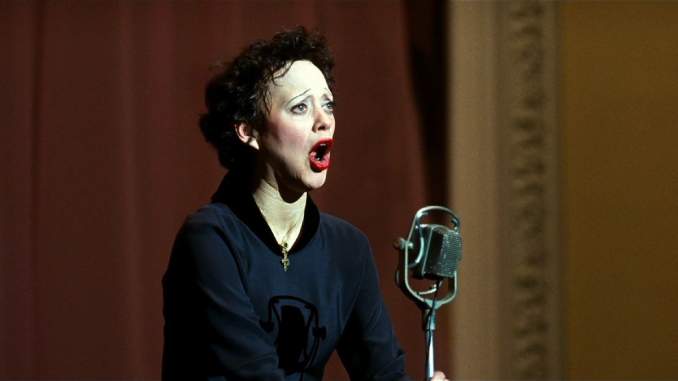La Vie en Rose and the Queer Art of Lip Syncing

Edith Piaf’s “La Vie en Rose” is a nostalgic song. The lyrics long for the rose-colored world of familiar love. The song also packages nostalgia itself as shorthand for the WWII era, timeless romance and bygone peace. The song is so effective that we’re nostalgic for a film that’s not as good as we remember.
La Vie en Rose, the 2007 biopic of the great glottal chanteuse Edith Piaf, starring Marion Cotillard, structures its timeline so that we’re disoriented from time, not sure how close we are to the end. This nonlinearity would be effective if the scenes we saw were interesting. But alas, they are rehearsed and dour versions of every other Tragic Diva story. And because director Olivier Dahan shows us what happens at the beginning of the film, watching the movie fills us with boredom while we wait for something to happen.
That something is Cotillard. Her speaking performance of Piaf as a toadish gerbil is hilarious, effective and a marvelous example of control, yet it gets lost in the one-dimensionality of the narrative. Still, Cotillard’s architecture for her character allows her to become multi-dimensional. Her younger Piaf is properly doe-eyed and shrunken, straightening as Piaf blossoms, then hunching as she withers prematurely from morphine dependence. Underneath the red cotton-ball wig is an artist puppeteering her face and voice without dropping a thread.
Cotillard’s mastery of articulation creeps to the forefront when she’s lip-syncing. Her numbers as Piaf show an actress deeply in tune with the orchestra of her face. By pulling, lifting and straining—replicating the mechanics of singing—she brings us further into Edith Piaf. Most biopics of singers want us to know the human behind the voice, but Cotillard’s performance is different: It focuses on the body that contained, controlled, produced and lost the voice.
It’s the industry standard for actors performing musical numbers to lip sync to playback. It retains the “purity” of the sound and guarantees a “good’’ vocal performance each take. But this comes with a double bind. Even if the performer is fortunate enough to record their own vocals when it comes to shooting the scene, they still have to mold their acting around emotional performances an artist imprinted in songs recorded some time ago. Cotillard’s sparrow is in a gilded cage of the film’s own making. She must plan her emotional build-ups and come-downs around Piaf’s decades-old feelings, archived in audio. She’s unlike her fellow lip sync assassin, Angela Bassett, who had the benefit of having her person-character alive to lay down new vocals to fit What’s Love Got to Do with It’s emotional beats.
-

-

-

-

- Curated Home Page Articles By Test Admin October 21, 2025 | 3:10pm
-

- Curated Home Page Articles By Test Admin October 21, 2025 | 2:57pm
- Urls By Test Admin October 21, 2025 | 2:57pm
- Curated Home Page Articles By Test Admin October 21, 2025 | 2:55pm
-

-

-

-

-

-

-

-

-

-

-

-

-

-

-

-

-

-

-

-

-

-

-

-

-

-

-

-

-

-

-




































